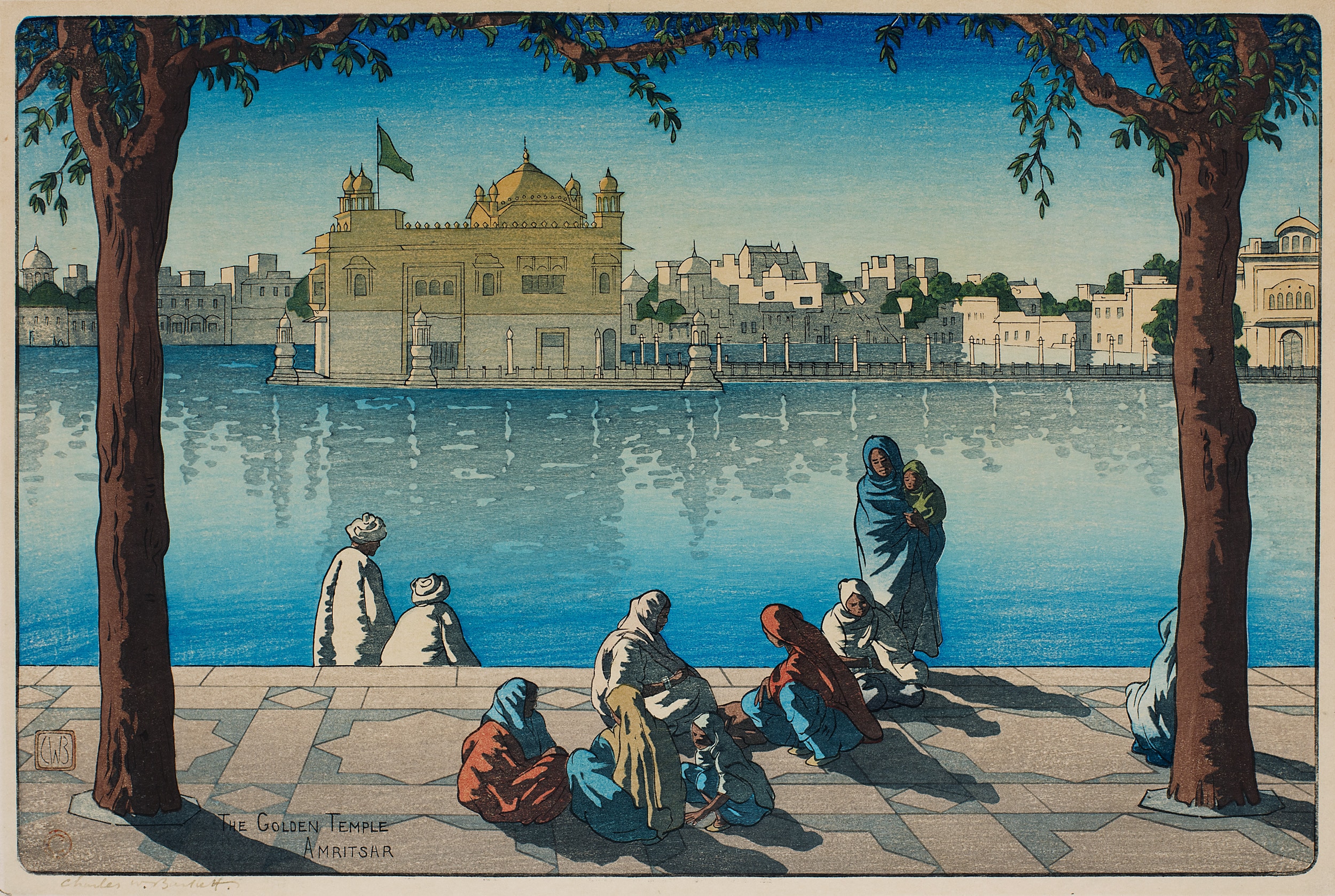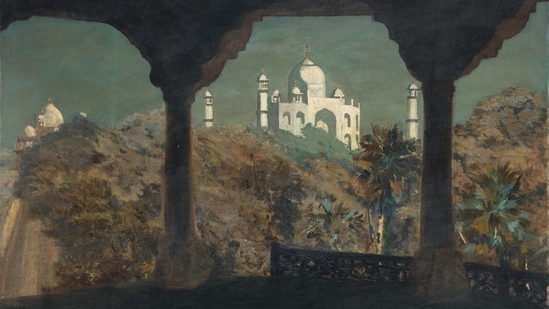A different Orient Express
The morning after the opening of ‘Destination India: Foreign Artists in India (1857-1947)’ at the Delhi Art Gallery (DAG) in Janpath saw a significant number of people politely jostling as they took their place around Giles Tillotson and Aditi Mazumdar, who were leading the first walkthrough of the exhibition. Some mopped the sweat off their brows and moustaches while others reached into their bags to put their phones on silent, and craned their necks to look around and greet fellow art lovers who’d braved the deathly humidity that had Delhi in its grasp at this time of the year. One wonders what Marius Bauer, Carlton Alfred Smith, Erich Kips, Hugo Pedersen, Hiroshi Yoshida or even Maurice Levis, would have made of this particular scene — these Orientalist painters who travelled to India not only to capture the grand monuments, temples, mosques, forts and royal cities, but set their sights on the ordinary, people and rituals both, to tell a story of India that went beyond the obvious. “These paintings indicate the presence of a distinct movement, based on what they have in common between them, and the difference between them and what came before,” said Tillotson, senior vice president, exhibitions, DAG.
PREMIUM The Taj Mahal by Hugo Vilfred Pedersen- Oil on canvas pasted on plywood 23.0 x 35.0 in.(Delhi Art Gallery)
He is referring to the widely-known names of Orientalist art in the 19th century, such as Eugène Delacroix, Henri Matisse, David Roberts and Ludwig Deutsch, who travelled from Europe towards Palestine, Syria, Morocco and Egypt; and thanks to them, the popular understanding of Orientalist art is tethered to an audacious use of colour, frames filled with architectural details, landscapes featuring animals that were as foreign to the Western world as the people who lived alongside them. “Before Edward Said hijacked the word, Orientalism referred to the art-historical term of the depiction of subjects in North Africa and the Near East by European painters; it grew out of a relationship between art and tourism of a kind. They painted views of everyday life in the countries they travelled through, which became very popular in the salons of Paris at the time,” said Tillotson.
 Benares am Goldenen Tor (Benares at the Golden Gate) by Erich Kips Oil on cardboard 19.7 x 13.7 in.(Delhi Art Gallery)
Benares am Goldenen Tor (Benares at the Golden Gate) by Erich Kips Oil on cardboard 19.7 x 13.7 in.(Delhi Art Gallery)
But Orientalism as a style seemed limited to the Islamic countries and the Eastern chapter from India went unnoticed because, for a long time, Damascus in Syria was considered the place where the East ended. “Sitting here in Delhi, we can say that is where the East begins! At DAG, we’ve been looking at British and European artists who were working in India in slightly earlier periods, such as William Hodges, Thomas and William Daniell, and Balthazar Solvyns, who were visiting this part of the British empire during the end of the 18th century and their work survived into the 19th century. Now, as the popular narrative goes, the camera then took over as the primary medium to record India. But that didn’t mean that there were no paintings anymore,” said Tillotson. While unpacking works purchased by DAG abroad and brought to India, he and Mazumdar, a researcher at the gallery, were pointed in another direction — the works of Bauer, who came to India at the end of the 19th century — and he wasn’t alone. “There were more foreign artists, Danish, Italian, Japanese, Germans; it wasn’t just the British any longer. The Orientalist story in India needed to be revised,” he added.
 The Golden Temple, Amritsar by Charles William Bartlett-Kokka woodblock print on paper, c. 1919(Delhi Art Gallery)
The Golden Temple, Amritsar by Charles William Bartlett-Kokka woodblock print on paper, c. 1919(Delhi Art Gallery)
This is not to say that Said’s rethinking of Orientalism is not at play at this exhibition. The exotic is very much alive, but the gaze has shifted a little. The difference between the earlier crop of artists and the ones exhibited at DAG is that the former were taking part in the Age of Discovery and Enlightenment — they had to explain India to the West. By the time, the foreign artists of Destination India arrived on these shores, the Taj Mahal had started to become something of a cliché. “In these paintings, there are aspects that exoticise, mythologise and mysticise India. There is an awareness, though, especially with someone like Bauer who knows he’s creating a fantasy based on what he’s seeing. He called it ‘post-dreaming’,” said Tillotson. Bauer’s work adorns the entrance, with etchings on paper, and watercolours on Whatman boards; his use of colour is economical, and unexpected considering that so many Orientalist artworks are awash with pigments. He rejects the need for total realism, this is an India that exists on multiple planes, making Bauer a delightfully unreliable narrator. “His images show you how an indigenous culture is enduring colonialist interventions even though he is travelling through India in the mid-1920s,” said Mazumdar during the walkthrough.
Most of the artists on display have devoted themselves to depicting scenes from everyday life, the mundane and the commonplace, such as the market in The Corner of a Fruit Market by Mortimer Menpes; but this is unlike the Orientalist souk or bazaar scenes one has seen emerge from Morocco or Egypt. These artists aim to show India along with its people who live in and around the now-famed monuments (The Taj Mahal by Pedersen), mosques (Jumma Masjid by William Simpson), temples (The Golden Temple by Charles William Bartlett), and ghats (Benaras at the Golden Gate by Kips), or simply a road scene (Native Gharry in Ahmedabad by Edwin Lord Weeks) and the various cultures that co-exist side by side. The exhibition also features works by two women: Mary Anne Blyth, who was likely to be the wife of a British civil or military officer, and Constance Frederica Gordon-Cumming, a globetrotter, a rare woman travel writer, and a self-taught landscape painter from Scotland.
 The Corner of a Fruit Market, Delhi by Mortimer Menpes Oil and mixed media on cardboard, c. 1903(Delhi Art Gallery)
The Corner of a Fruit Market, Delhi by Mortimer Menpes Oil and mixed media on cardboard, c. 1903(Delhi Art Gallery)
One of the highlights of ‘Destination India’ is the section where the British artist Bartlett, whose depiction of Indian scenes and structures in a traditional Japanese woodblock print style, faces the works of Shin Hanga (New Prints) master, Hiroshi Yoshida. Bartlett had travelled to Japan in 1915, where he met the print publisher Shozaburo Watanabe, the driving force behind the Shin Hanga movement, and collaborated on publishing a series of drawings, including six Indian scenes from Bartlett’s earlier expedition to India in 1913. Five years later, Yoshida would collaborate with Watanabe as well, to produce topographical prints. In 1930, the famed Japanese artist would travel through the established tourist hubs of the subcontinent, Delhi, Agra, Benares, Rajasthan, and Srinagar, among others, and produced prints that were inscribed in Japanese and English; Yoshida’s commercial ambitions went beyond Japan, he wanted the West to buy his work. “He quickly realised that people were interested in different countries and what they looked like, so he began to tour all over the world and create these prints,” said Mazumdar.
Did any of these artists ever settle down in India? Not exactly. Two works on display, Portrait of Elderly Indians, and Head of a Young Woman belong to the Italian painter Olinto Ghilardi, who is famous for being Abanindranath Tagore’s mentor and served as the vice principal of the Government School of Art in Calcutta from 1885 to 1886, and later from 1888 till 1905. Ghilardi encouraged Tagore to embrace pastels and gouache and was known for introducing ideas from Western art movements to what became the Bengal School of Art. However, he returned to Italy in 1905 and that was the end of his relationship with India.
Also living in India in a professional capacity as an art teacher was John Griffiths, who taught at the Sir J.J. School of Art in Bombay from 1865 onwards, and served as its principal from 1880 to 1895. In 1899, he was succeeded in that office by Cecil Burns, who held the position till 1918. “The pupils who passed through the school during this period include the Parsi portrait painters Pestonji Bomanji and M.F. Pithawalla; the portraitist and landscape painter (and in his own time, drawing instructor) M.V. Dhurandhar; and a host of landscape watercolourists including N.R. Sardesai, L.N. Taskar and M.K. Parendekar. All imbibed the naturalistic methods advocated by Griffiths and Burns,” writes Tillotson in the exhibition catalogue. As for the others, did they interact with the local artists while they gazed, fantasised, reimagined and reproduced scenes from India? That is very unlikely, said Tillotson, and entirely their loss.
Destination India is on at the DAG, New Delhi, till August 24
Images are for reference only.Images and contents gathered automatic from google or 3rd party sources.All rights on the images and contents are with their legal original owners.


Comments are closed, but trackbacks and pingbacks are open.